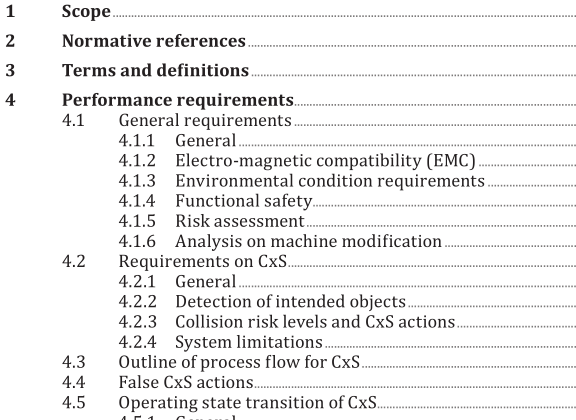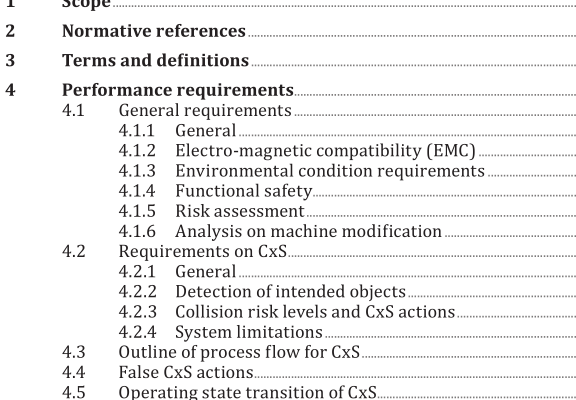ISO 21815-1:2022 pdf download – Earth-moving machinery — Collision warning and avoidance — Part 1: General requirements.
1 Scope This document provides terminology and general guidance on the principles of collision warning and collision avoidance systems for: — earth moving machinery as defined in ISO 6165, — mobile underground mining machinery as defined in ISO 19296, and — road construction machinery as defined in ISO 22242. This document provides general requirements for detection of objects, warnings to the operator, automatic intervention control to avoid collision, and test procedures. It is intended to be used in conjunction with the other parts of the ISO 21815 series, which provide detailed guidance and requirements for collision warning and collision avoidance systems and determining risk areas and risk levels. The specific requirements and definitions for particular types of machines are defined in the use case parts of the ISO 21815 series. This document covers collision avoidance by speed reduction or motion inhibit: it does not cover avoidance by automatic manoeuvring (e.g. steering) away from the intended object. The systems described in this document are only intended to assist the operator of the machine. The responsibility for safe operation of the machine remains with the operator of the machine. This document is not applicable to collision warning and collision avoidance systems installed to the machine before the date of its publication. 2 Normative references The following documents are referred to in the text in such a way that some or all of their content constitutes requirements of this document. For dated references, only the edition cited applies. For undated references, the latest edition of the referenced document (including any amendments) applies. ISO 3450:2011, Earth-moving machinery — Wheeled or high-speed rubber-tracked machines — Performance requirements and test procedures for brake systems ISO 12100:2010, Safety of machinery — General principles for design — Risk assessment and risk reduction ISO 13766-1, Earth-moving and building construction machinery — Electromagnetic compatibility (EMC) of machines with internal electrical power supply — Part 1: General EMC requirements under typical electromagnetic environmental conditions ISO 13766-2, Earth-moving and building construction machinery — Electromagnetic compatibility (EMC) of machines with internal electrical power supply — Part 2: Additional EMC requirements for functional safety ISO 13849 (all parts), Safety of machinery — Safety-related parts of control systems
3? Terms? and? definitions For the purposes of this document, the terms and definitions given in ISO 12100 and the following apply. ISO and IEC maintain terminology databases for use in standardization at the following addresses: — ISO Online browsing platform: available at https:// www .iso .org/ obp — IEC Electropedia: available at https:// www .electropedia .org/ 3.1 interaction situation where a machine encounters an intended object (3.5) when moving or about to move, placing itself or the operator at risk, or exposing the intended objects to risk 3.2 warning transmission of alert information by visual, audible or other means of signals Note 1 to entry: Warning is targeted to the operator and also can be for people located in close proximity to the machine in addition to operator. 3.3 evasive action action initiated by the operator to attempt to prevent or avoid a foreseeable collision EXAMPLE Braking, steering. 3.4 interventional collision avoidance action automatic action initiated by a collision avoidance system (CAS) (3.9) to attempt to prevent or avoid a foreseeable collision EXAMPLE Braking, inhibiting motion, slowing down. 3.5 intended object object, such as a person, machine, vehicle or obstacle, which is intended to be detected by a collision warning system (CWS) (3.8) or a collision avoidance system (CAS) (3.9) when in the collision risk area (3.7) 3.6 collision risk level value that is assigned each intended object (3.5) to determine if a collision is foreseeable Note 1 to entry: Collision risk levels are described in ISO 21815-3 and a future part of the ISO 21815 series dedicated to risk area and risk level for track movement and swing/rotation. 3.7 collision risk area space analysed to determine the collision risk level (3.6) 3.8 collision warning system CWS system which detects intended objects (3.5) in the collision risk area (3.7), determines the collision risk level (3.6) and provides a warning (3.2) to the operator
ISO 21815-1:2022 pdf download – Earth-moving machinery — Collision warning and avoidance — Part 1: General requirements






